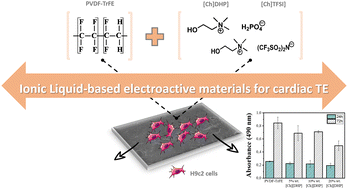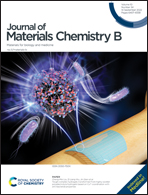Ionic liquid-based electroactive materials: a novel approach for cardiac tissue engineering strategies†
Abstract
Cardiac tissue regeneration strategies are increasingly taking advantage of electroactive scaffolds to actively recreate the tissue microenvironment. In this context, this work reports on advanced materials based on two different ionic liquids (ILs), 2-hydroxyethyl-trimethylammonium dihydrogen phosphate ([Ch][DHP]) and choline bis(trifluoromethylsulfonyl)imide ([Ch][TFSI]), combined with poly(vinylidene fluoride-co-trifluoroethylene) (P(VDF-TrFE)) for the development of ionic electroactive IL/polymer hybrid materials for cardiac tissue engineering (TE). The morphological, physico-chemical, thermal and electrical properties of the hybrid materials, as well as their potential use as scaffolds for cardiac TE applications, were evaluated. Besides inducing changes in surface topography, roughness and wettability of the composites, the incorporation of [Ch][DHP] and [Ch][TFSI] leads to the increase in surface (σsurface) and volume (σvolume) electrical conductivities. Furthermore, washing the hybrid samples with phosphate-buffered saline solution strongly decreases the σsurface, whereas σsurface and σvolume of the composites remain almost unaltered after exposure to ultraviolet sterilization treatment. Additionally, it is verified that the incorporation of IL influences the P(VDF-TrFE) microstructure and crystallization process, acting as a defect during its crystallization. Cytotoxicity assays revealed that hybrid films based on [Ch][DHP] alone are not cytotoxic. These films also support H9c2 myoblast cell adhesion and proliferation, demonstrating their suitability for cardiac TE strategies based on electroactive microenvironments.



 Please wait while we load your content...
Please wait while we load your content...